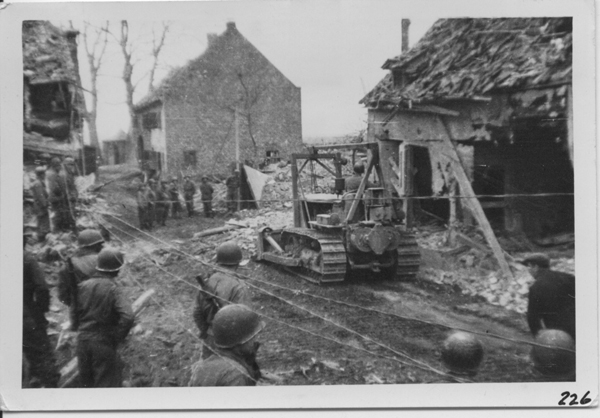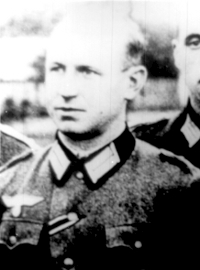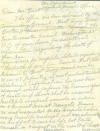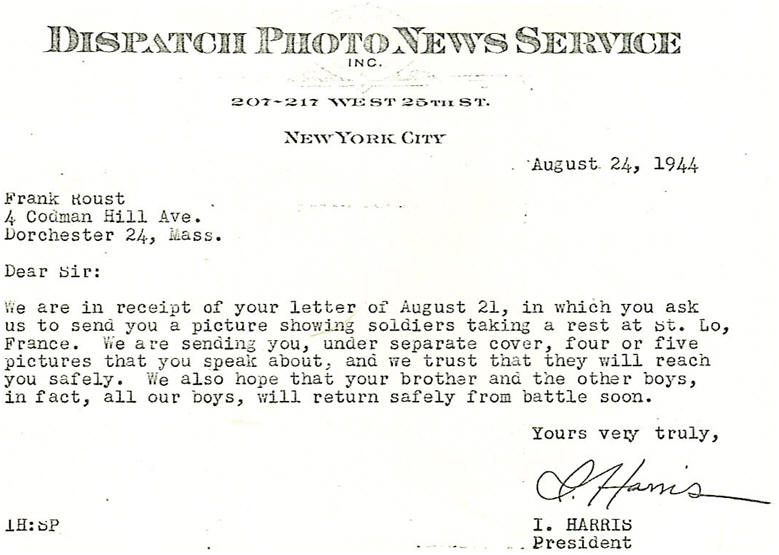 The only
street in Bettenhoven from the Dr. Heely collection of the 113th FA.
The only
street in Bettenhoven from the Dr. Heely collection of the 113th FA. German soldier graves along that same street in Bettenhoven.
German soldier graves along that same street in Bettenhoven.
 German soldier graves in Roedingen.
German soldier graves in Roedingen.
Page 1
Page 2
Page 3
Page 4 Page
5 Page 6 Page
7
Page 8
Page 9 Page 10
Page 11 Page
12 Page 13
Page 14
Page 16
REPORTS Page 15
The Battle of Hoellen and Roedingen, Feb. 25 1945...tremendous link--a must see and read!!! Many thanks to Willi Weiss.
 The only
street in Bettenhoven from the Dr. Heely collection of the 113th FA.
The only
street in Bettenhoven from the Dr. Heely collection of the 113th FA.
 German soldier graves along that same street in Bettenhoven.
German soldier graves along that same street in Bettenhoven.
 German soldier graves in Roedingen.
German soldier graves in Roedingen.
 German 88 converted for shooting at targets on the ground. In the
background you can see the first houses of Steinstrass.
German 88 converted for shooting at targets on the ground. In the
background you can see the first houses of Steinstrass.
A pay book ( Soldbuch ) from a physician ( Oberarzt ) Dr.
Werner
Latzel of the 12th VGD ( 12. Volksgenadier Division ) - ( San Ers Abt
6 / 12.VGD )
He fought at the Reichsstrasse 55 Stetternich - Steinstrass - In
the area of 30th.



___________________________________________________________________________________________________________
_________________________________________________________________________________________________________________________________________________________________
Rare Curlew "Headliner" newspapers published in Bad Elster, Germany....June 1945
_________________________________________________________________________________________________________________________________________________
I’m looking for anyone that might have known my father, Private Harold C.
Suit (Hal) from Struthers, Ohio, 120th Infantry, A Company. He
joined the 30th in England, was wounded in left shoulder at
Saint-Lo,
and lost a leg to direct tank fire at Birk, Germany just north of Aachen on
10 October 1944. Among his accommodations, the Purple Heart with Oak
leaf Cluster, Bronze Star and the Silver Star for his actions at Burk. I
believe he was a member of the third platoon, I know he was Platoon Guide,
and was known was his love of night patrolling.
Regards
W. Dennis Suit
wdsuit@mindstring.com
Aerial photo of the Birk area....1944. CLICK HERE TO VIEW!!! (Microsoft Word Document)
__________________________________________________________________________________________________________________________________
______________________________________________________________________________________________________________________________________
Pfc. Edward
Roust
119th Infantry Regiment
Company G
Attached is information on Edward Roust who is in the picture.
Edward is from Charlestown Massachusetts. Charlestown is a one square mile
neighborhood in Boston.
We had one of the highest enlistment rates in the Country during WWII. 5,000 men
served in WWII from our 1 square mile neighborhood.
Edward is one of 100 men killed. He is one of six men killed in the Battle of
Normandy and the breakout.
Donated by the Edward Roust Family.
Submitted by: Bill Durette
Charlestown Veterans History Project

![]()


Please click to enlarge
thumbnails...thanks!
July 26th
1944, Dispatch Photo News Service
picture that was sent out around the world. On the right sitting down is Edward
Roust from Charlestown Boston Mass.
The picture was taken 9 days before he was wounded by
Shrapnel South of St Lo. He eventually died from his wounds on August 8th.
An original copy of the picture was given to
Edward’s father Frank Roust.

_______________________________________________________________________________________________________________________________________________________

Tremendous story provided by Erwin
Loos:
______________________________________________________________________
Edmund Lekki of Rome still becomes emotional when he recalls taking part in a momentous World War II battle that began 65 years ago this coming Wednesday.
Lekki, 87, of Merrick Road, survived a serious neck wound during the Battle of the Bulge, which began Dec. 16, 1944 and ended Jan. 25, 1945.
After being wounded on Jan. 15, "I laid in snow two to three feet deep....If it wasn’t for the snow, I wouldn’t be here. I would have bled to death," says Lekki. He said he still has "a piece of metal in my neck" from the shrapnel wound.
Lekki, who was a private first class in the Army’s 30th Infantry Division, said he also becomes "kind of emotional" and "it kind of bothers me" still when he thinks about fellow troops who did not survive.
For Nazi Germany dictator Adolf Hitler, the battle "was his last stand....People don’t realize that either," Lekki said of the way it is recognized today. "We lost a lot of men in that Battle of the Bulge."
It was Germany’s last major offensive of WWII, and was the largest land battle of WWII in which the U.S. participated. About 19,000 U.S. troops were killed, and the Germans’ defeat in the battle helped lead to the end of the war in Europe less than four months later, by May 1945. The battle’s name stems from the large "bulge" that the German attack created in U.S. lines within the Ardennes Forest along the Belgian/German border.
Lekki, originally from Ava, remembers that his division was positioned near Malmedy, Belgium, during the battle, including "big hills....a lot of woods" in the Ardennes terrain.
On Jan. 15 "I got hit," said Lekki, recalling that the Germans were "shelling us." He said the neck wound came from a mortar shell, and he believes that his bleeding was slowed down by being in the snow. Lekki said he received medical treatment for about 10 months. He left the Army in late 1945, after having entered in 1942.
Lekki said he eventually learned of the steel shrapnel piece in his neck, and he does not know how it was left there. He referred to it as "my souvenir....I’ll take it to the grave with me."
Lekki said he went on to work for Revere Copper & Brass, retiring after 37 years. He said he has been married for 57 years, and has two children.
His older brother, Frank Lekki Jr., also of Rome, served in the miliary as well during WWII; he was in the Army Medical Corps, and was stationed stateside where he helped wounded troops recuperate. In 2007 the two brothers were among several hundred WWII veterans from Oneida County who participated in specially organized bus trips to Washington, D.C. to visit the WWII memorial and other monuments.
______________________________________________________________________________________
Link to another great 30th Veteran Story: http://www.lehighvalleylive.com/jim-deegan/index.ssf/2009/11/on_veterans_day_a_personal_sal.html
______________________________________________________________________________________
Hi, My name Is Stefan Kahlen, 1953 born in Wuerselen, close to Aachen, Germany.…I attach three pics to this email.
1. This map may be useful for your site. It shows the frontline 10/20/1944
10/2/1944
the 30. US Infanteriedivision started the attack in the Rimburg / Palenberg
area in order to capture Aachen from the north.
From the south the 1. US Infanteriedivision started 10/8/1944.The map shows
the area profits of the US Army till the occupation of Aachen
2.
10/9/1944 soldiers of the 30. US Infanteriedivision invaded Morsbach.
Morsbach was a small spot between Wuerselen and Bardenberg.
Today Morsbach and Bardenberg are districts of Wuerselen.
3. March 1945: In the middle: Major Edwin Tribble, commander of Wuerselen and Bardenberg.
Source: Heimatblaetter des Kreises Aachen-1978
HAPPY NEW YEAR, have a great time!
Stefan Kahlen, Germany
_________________________________________________________________________________
First Lt. Joseph C. Elinski, 117th Infantry Regiment, Co. L, 3rd Platoon:
Dear Joe,
A few lines to say hello an
let you no I’m O.K. How is it going
up there. I hope it’s not as hot as it was
when I left. I ran into a few of the
fellows on my way back. I’m in a
general hospital. It really seems funny
writing with lights on, sleeping between
sheets.
Well I reckon I will be on my
way back pretty soon. Give all the
fellows my regards an take care of
your self.
C. Hall
____________________________________________________________________________________________________________________________________________________________________
Capt. William B. Carlton, 113th Field Artillery, Headquarters Battery:
Warren,
I am pleased to learn of your Web site; Buster Simmons forwarded the “After Action Report” message about the capture of the German anti-aircraft gun, and I followed the link to your site. My dad was W.B. (Bill) Carlton, Jr. of the 113th FA, HQ Btry. He was a captain when they landed in Normandy, and retired a colonel in 1967. He and my mother are buried at the Post Cemetery, Ft. Sill. My dad enlisted in 1938 in HQ Btry, 1/115th Field Artillery in Murfreesboro, TN. It was pretty much a local unit at that time. When the 30th was activated in 1940, everything changed. He was granted a direct commission during the Tennessee maneuvers in 1941, and then went to Ft. Sill to attend the Officers’ Basic Course. While he was there, the 115th was sent to Iceland to replace the Brits, and my dad and another officer were transferred to the 113th. My dad assumed Abbott Weatherly’s command in 1942 (when Weatherly transferred to A Btry) and commanded HQ Btry until the end of the war. You are probably familiar with the LST 133 disaster; it was HQ Btry that was decimated in that catastrophe: http://www.30thinfantry.org/bn_disaster.shtml. My dad told me not long before his death that LST 133 had been refitted and used in the Pacific Theater, then was used as a target at Bikini Atoll. It is always a pleasure to connect with people who know and care about the 30th. My husband and I attended several reunions with my dad, and were privileged to accompany him on the Europe trip in 1999. We attended the reunion last fall in Raleigh, and hope to be able to go again this year to welcome the 30th HBCT back from Iraq.
Regards,
Lane
Warren, I spent some time looking yesterday at the treasures you have in Van Heely’s pictures. Many of them I have never seen, so I’m pleased to have that opportunity. What a gold mine! The attached photo is one I can’t identify in context. When my dad lost his sight, he sent most of his WWII mementos to me, and this picture was among those things. He was pretty good about identifying most of the other photos, but this one has, in addition to the censor’s stamp on the back, only the words “Germany 1945.” I tried to describe the setting to my dad, but he did not recall the event, whatever it is. I sent a copy of the photo to his First Sergeant Kirby Rose in NC, and he identified the officers walking away as Col Griffin and (probably) the general’s aide (whose name I have in some “safe” place), but did not know the identities of the other dignitaries or the reason for the photo. My dad is second from the end on the left in the first row, and to his left is “Skeeter” Horner. If this photo rings a bell with something you have seen or read about, and you can find some context for the photo, I’d be grateful.
Regards-
Lane
Artillery brings dignity to what would otherwise be just a brawl
_________________________________________________________________________________________________________________________________________________________________________
New York Times newspaper article by Drew Middleton describing Oct. Siegfried Line breakthrough.
New York Times newspaper article number 2 by Mr. Middleton. (Microsoft Word documents.)
__________________________________________________________________________________________________________________
WITH THE AMERICAN FIRST ARMY, in Germany, Oct. 4 – A Letter to the editors of THE NEW YORK TIMES, written “in the name of all the inhabitants of the city of Maastricht,” the Netherlands, to thank the United States for the town’s liberation, is on its was to New York, according to Het Parool, a Maastricht newspaper.
The letter thanks America through THE NEW YORK TIMES “for the arrival of you boys who have brought us the liberty for which we have longed so fervently.”
TEXT OF LETTER
The text of the letter follows:
To the Editors of THE NEW YORK TIMES:
We, the inhabitants of Maastricht, citizens of the first liberated town of the Netherlands, want an opportunity to thank you for the arrival of your boys who have brought us the liberty for which we have longed so fervently.
We need not describe to you our suffering and our want. The tyrant robbed us of everything that has been dear to us. He tried to destroy our culture; our unions were dissolved, our religion was hindered, our men and boys were carried off, our food was stolen, our horses and our cattle were stolen, our bicycles were transported to Germany and even our hens had to lay their eggs for Huns. Only German music was heard, and with great danger we had to listen secretly to our friends who brought us news.
Our children became underfed, badly clothed and had to wear worn out shoes; old Dutch wooden shoes became by force the fashion again.
Each new day brought new pain and new care. Our young people have no youth. They were chased and hidden in cellars and woods.
Such was our situation – and then your boys came. Can you, readers, conceive and realize with what joy we welcomed them.
Can you imagine how we wept when we could shake hands with the first American boys.
Thanks, many thanks for the arrival of your dear boys. And they were beyond all expectation; what a wrong idea we had about America and its people.
The pleasant smile of your boys has stolen our hearts. Their laughing faces, their vigorous and brave appearance, their kindheartedness and especially their simplicity have told us that these sons of the great American Republic bear true democracy in their hearts and that the world may be glad the United States has interested itself in behalf of our country and of Europe.
How we shouted for joy and feasted with them and how we shared with the greatest pleasure the little we could still give. How wise of your commanders to forbid the boys to buy here. Our enemies robbed and plundered and you soldiers have been instructed not to take the little that can be bought for money.
Thank you for all this; thank you for the arrival of your boys – God bless America and its soldiers in their battle. May He carry your boys safely back to their country. God bless many American mothers who have given the dearest they possess for the liberation of our country and of Europe.
We Dutch people shall never forget the sacrifices that America has made and we shall pray that your battle and victory may be the beginning of a new time, a time of understanding and goodwill.
God bless the United States and its citizens, God save the dear boys who have brought us freedom and who have captured our hearts by their strength, their kindness and their good nature.
Thank you – once again thank you.
(Singed)
IN THE NAME OF ALL INHABITANTS OF THE CITY OF MAASTRICHT.
This newspaper expects in the near future to receive a letter written “in the name of all inhabitants of the city of Maastricht,” which lies on the left bank of the Maas River in that part of the Netherlands which is almost pinched off by Belgium on the west and Germany on the east. The text of the letter arrived by wireless on Wednesday. It speaks of what went on under the German occupation; horses, cattle, food and bicycles stolen; labor unions dissolved; men and boys carried off; the young people “chased and hidden in cellars and woods.” The Dutch humor survived. “Even our hens.” Says the letter. “had to lay their eggs for Huns.”
Then the Americans walked in. As to them, this is the testimony of the people of Maastricht:
The pleasant smile of your boys has stolen our hearts. Their laughing faces, their vigorous and brave appearance, their kindheartedness and especially their simplicity have told us that these sons of the great American Republic bear true democracy in their hearts and that the world may be glad the United States has interested itself in behalf of our country and of Europe.
This is what “invasion” means to Netherlanders when the “invaders” are Americans. We needn’t doubt that any other Allied contingent would have made a good impression, but the parents, sweethearts and friends of American boys on the Western Front can take a special pride in this tribute – which wasn’t extorted from unwilling signers by any A. E. F. version of the Gestapo. The description happens to fit the soldiers we all know best, and for a moment it lifts the black curtain of war on a cheerful and hopeful scene.